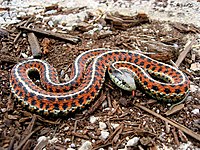
Photo from wikipedia
Abstract The propagations of diseases, behaviors and information in real systems are rarely independent of each other, but they are coevolving with strong interactions. To uncover the dynamical mechanisms, the… Click to show full abstract
Abstract The propagations of diseases, behaviors and information in real systems are rarely independent of each other, but they are coevolving with strong interactions. To uncover the dynamical mechanisms, the evolving spatiotemporal patterns and critical phenomena of networked coevolution spreading are extremely important, which provide theoretical foundations for us to control epidemic spreading, predict collective behaviors in social systems, and so on. The coevolution spreading dynamics in complex networks has thus attracted much attention in many disciplines. In this review, we introduce recent progress in the study of coevolution spreading dynamics, emphasizing the contributions from the perspectives of statistical mechanics and network science. The theoretical methods, critical phenomena, phase transitions, interacting mechanisms, and effects of network topology for four representative types of coevolution spreading mechanisms, including the coevolution of biological contagions, social contagions, epidemic–awareness, and epidemic–resources, are presented in detail, and the challenges in this field as well as open issues for future studies are also discussed.
Journal Title: Physics Reports
Year Published: 2019
Link to full text (if available)
Share on Social Media: Sign Up to like & get
recommendations!